Skirt silhouettes and styling for men
In wanting to wear skirts at contra dances, a question that quickly arose was how to do so without looking ridiculous. After all, in the Western world, skirted garments have been almost exclusively worn by women for the past several hundred years.
Skirts within menswear aren't unheard of, with the Scottish kilt being the most widely known. Men wearing other skirts, though, typically look odd. Why does the kilt work, whereas others frequently do not?
A good place to begin answering this question is by looking at differences in body shape. While there is a great deal of variation in both men and women, a basic understanding can be drawn from the following observations:
- Men tend to have broad shoulders, narrow hips, and a relatively 'straight' torso.
- Women tend to have narrow shoulders in proportion to their hips, a narrower waist, and smooth curves joining the two.
Much fashion design is based on exaggerating these body features. For example, hundreds of years of European female fashion is rooted in the 'hourglass' shape that most women possess, as well as the emphasis on different parts of it.
Skirts on women also tend to create appealing visual lines due to the smooth curves of the body around the waist and hip areas. These curves can be extrapolated in many ways, flaring wide, hanging in a triangle, or contouring close to the legs.

The general visual focus on male bodies, however, is typically on the broad shoulders. Styling advice for men often recommends accentuating these features and de-emphasising the hips, exaggerating the visual mass of the upper body.
Because skirts have primarily been worn by women recently, the garments widely available were designed to harmonise with common female body shapes. When worn by men, those garments often exaggerate body features the wearer does not have.
Thus, I feel that it is best to explore male skirts as an independent category.
Skirt silhouettes that work on men
I think that the best way to start exploring skirted silhouettes for male body types is to look at the silhouettes of existing garments, as, despite the cultural taboo, men's skirts are by no means uncommon. Here are just a few examples:
- I'd imagine that most people have seen a man in a bathrobe or dressing gown.
- The Scottish kilt is also widely known – a slightly flared knee-length plaited skirt.
- There are many examples of skirted garments worn by men in Western fashion history, like medieval tunics and the 17th-century justaucorps, for instance.
- The Japanese kimono is a floor-length 'dress' with a boxy profile, worn by both men and women.
- And the Hakama resembles a floor-length skirt (there are divided and undivided versions).

I doubt that any of these silhouettes look weird to you, but why do they work? Personally, I think that visual subdivision is the key factor here.
Male shoulders are typically wider than the hips, which is often called an 'inverted triangle'. If we look at existing male skirted garments, we can see that, in most cases, the skirt part is similar in shape to the torso, as if it were mirrored vertically at the waist.
This creates a silhouette where the broad shoulders gently flow into a narrow waist, then flow out once again into the skirt. This kind of 'bow tie' silhouette could be considered a characteristic of the male skirted silhouette.
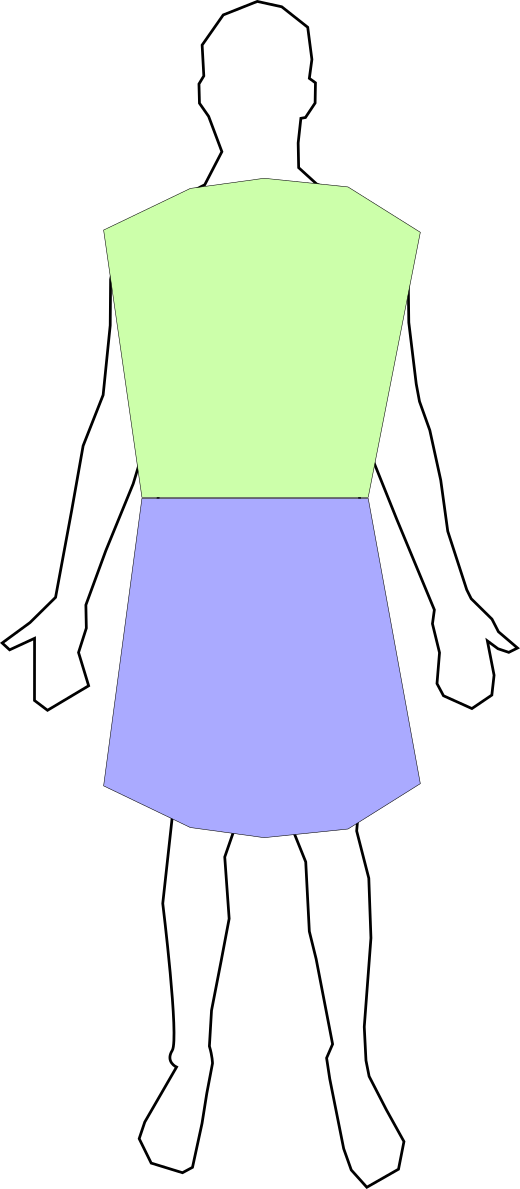
For many people, flipping the torso around the waist like this results in a skirt that is roughly knee-length, with the distance from the skirt to the floor approximately the same. This results in splitting the body from the shoulders down into three equal sections.
Many existing examples of historic male skirts are approximately knee-length, and the reasons given for this often relate to practicality, such as the need to do physical work. Still, it seems to me that visual appearance, as noted above, is also likely to factor in; it is widely known that people like the visuals of things in simple ratios.
For a longer skirt, the proportions become more like one third for the torso and two thirds for the skirt.
To me, the skirt's width looks most harmonious when about the same as the shoulders, though longer skirts can be a little wider while still looking balanced.

Another thing to consider is that men's torsos are typically quite broad and often lack a substantial difference in visual width between the waist and the hips.
As noted, many women's skirts deliberately bulk up the hips. My experience has been that bulking the hips on a man will often make the whole person look short and 'dumpy', because of the typically proportionally broad torso and lack of a waist for contrast.
It may be possible to make waist bulk look balanced if the shoulders are also bulked; examples of this can be seen in Tudor fashion. However, it may be preferable to avoid bulking the hips entirely. Traditionally made kilts actually cut out two layers of fabric from the top of the pleats, with the sole purpose of reducing waist and hip bulk.
A similar issue can arise from having a significant colour contrast between the top and bottom garments at the waistband. The contrast creates a horizontal line, resulting in an optical illusion that makes the waist look wider than it is. That can be addressed in a few ways:
- Obscuring the waist split by colour matching the top and bottom garments. Eliminating the division by wearing a 'dress-type' garment also solves that issue.
- The vertical stripe created by an open jacket or vest layered over other garments creates an optical illusion that makes the torso look longer and thinner.
- Wearing more fitted and shaped top garments that show any waist that the individual does have.
Skirts that flare too widely from the hips can also look out of place. I think that the root cause is that men's bodies are less curvy. On a woman, the innate hip curves provide a smooth 'ease in' to the line of a skirt at a wider flare angle, while on a male, the same produces a harsh angle.
What looks most natural to me is if the skirt's width at the hem is about the same as the shoulders, with garments narrower than this tending to make the person look top-heavy.
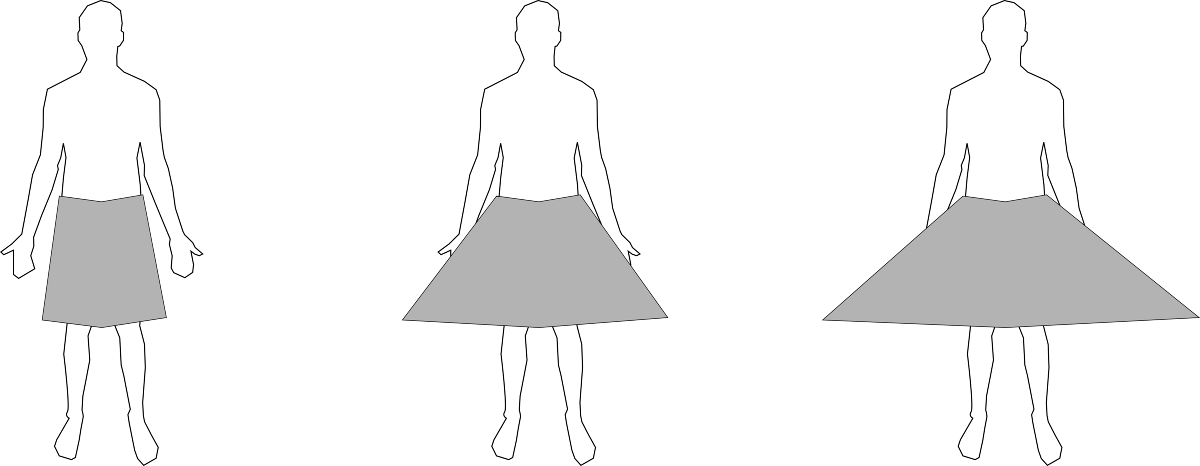
While adding bulk at the waist or hips rarely works to my eye, adding width low down can work, with the weight of the broad shoulders being balanced by a skirt that flares more towards the bottom. There are examples of this in some Chinese 'hanfu' clothing.
The same idea is probably why men's skirts tend to pair well with large boots, because they add visual weight to the lower body in counterbalance.
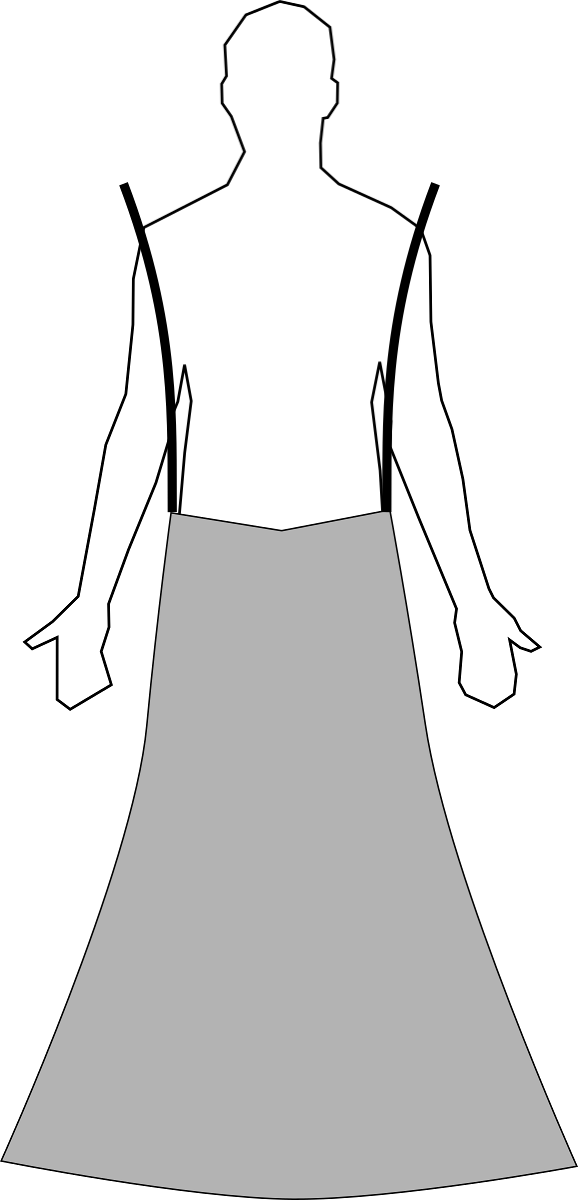
Choosing and styling skirts for men
So, having an idea of which silhouettes work, we can start looking for skirts and develop a style. One may want to consider several aspects:
Visual lines
When putting together an outfit, it is essential to consider the lines of the silhouette and how they relate to the outfit's overall visual balance. For example, how does the line from the shoulder down through the skirt flow?
Skirts can pair well with tank tops and vests, as they reduce the apparent width of the shoulders and create a clean visual line that runs from the shoulder right down to the bottom of the skirt. Wearing more fitted tops can enhance this effect.
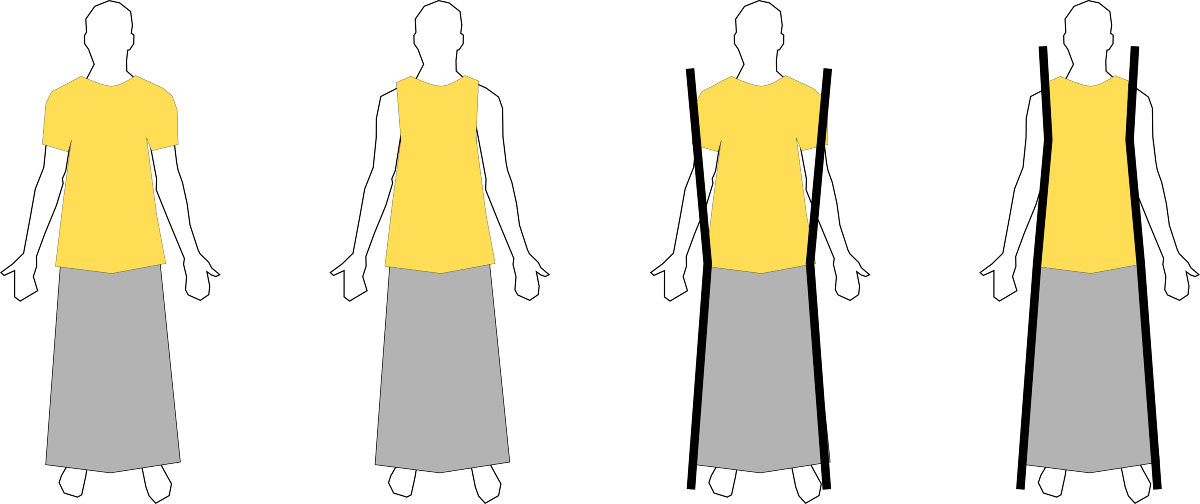
If one's skirt includes a curve and isn't just a linear flare, it is essential to consider how the lines of this curve extrapolate and where they end up landing on the upper body.

How the skirt hangs
An important factor to consider when looking for skirts for a male body is how the garment hangs on the body. As most skirts available today were designed for women, they were designed to flare out and fit around wide female hips. This creates two issues:
- Many skirts are made from lightweight, flowy fabrics and are designed to flare out at the hips. Without the body's shaping, the skirt will hang straight down, often in an unflattering way.
- If fitted at the waist, skirts in stiffer fabrics will often stand off the body at the hips, because they were shaped to contour around wider hips. This can create issues where the line of the outfit's silhouette conflicts with the natural shape of the person's body, curving outwards where it should not.
These issues can be addressed with skirts that flare less widely at the hips and create their own shape below that point by using stiffer fabric and a cut that will hold its own shape. In principle, using large volumes of fabric that will naturally stand off the body would also work.
Consistency in visual language
The term 'visual language' refers to the kinds of patterns found in visual design, for example, angles and straight lines, tight yet rounded forms, or large, flowing curves.
In clothing, visual language matters because there is an innate 'language' within different people's bodies. Some are more angular, while others are more rounded, and the visual language of the clothing needs to harmonise with these shapes:
- More angular body shapes may fit better with skirts that have more angular shapes, such as pleats.
- More curvy body shapes may blend better with skirts that are more flowy or ruffly in nature.
The visual language of an outfit needs to be both harmonious among the garments and with the body of the person wearing it.
It seems to me that women's fashion has often been based on curvaceous visual language, while men's fashion has become based on straight lines and angles. While people's bodies differ, I don't think this is accidental, since men's bodies are often more angular.
I think it should be possible to combine different kinds of visual language in a harmonising way, just as colours can be combined in complementary or contesting ways through colour theory. However, I do not know how to do this.
Fabric types, weights and colours
In creating a visually harmonious outfit, the factors of fabric type, weight, and colour matter more than one might expect. Western menswear has been constructed mainly from medium- to heavy-weight, relatively stiff fabrics in recent times, with colours tending to be dark earth tones and lacking patterns.
Examples of fabric include medium- to heavy-weight cotton twills, denim, French terry (the fabric used in hoodies and jogging bottoms), fleece, double knits, and twill-woven wool plaid (what kilts are traditionally made from).
Staying within these constraints helps male skirts not to look out of place to a viewer's eye. It also helps maintain a consistent visual language when skirts are paired with existing 'menswear' garments.
Visual focus of an outfit
Available skirts are often brightly coloured and patterned, while men's upper garments nowadays are not. However, when one views an outfit on a person, the eye tends to go to the part with the most detail.
Contrasted with plain upper garments, ruffly skirts or those with highly contrasting patterns tend to draw the viewer's eye downwards. This can be problematic on a man because the body's natural visual focus is on the shoulders.
I feel that male skirts should seek to avoid drawing too much attention, and extant male skirts from fashion history and other cultures often feature a plain front. Kilts, for instance, have a simple apron front, with the skirt's fullness moved to the back.
It may be possible to balance a ruffly skirt if the top garments are ruffly as well, but such would be a strong fashion statement nowadays.
Skirt lengths and balancing proportions
It seems to me that a great deal of what makes men's skirts look flattering is their proportion in relation to the rest of the outfit. Issues can quite easily arise with this, as many skirts are worn at the natural waist, around the level of the navel (belly button), while men's clothing today uses a 'waist' that is lower on the body.
Existing upper garments are often longer than ideal. Wearing a standard t-shirt over a knee-length skirt covers a notable proportion of the skirt, and to me, this looks top-heavy. The same outfit may look more balanced if the t-shirt is either tucked in or the skirt is worn with a 'cropped' top. Partial tucking or French tucking is also an option.
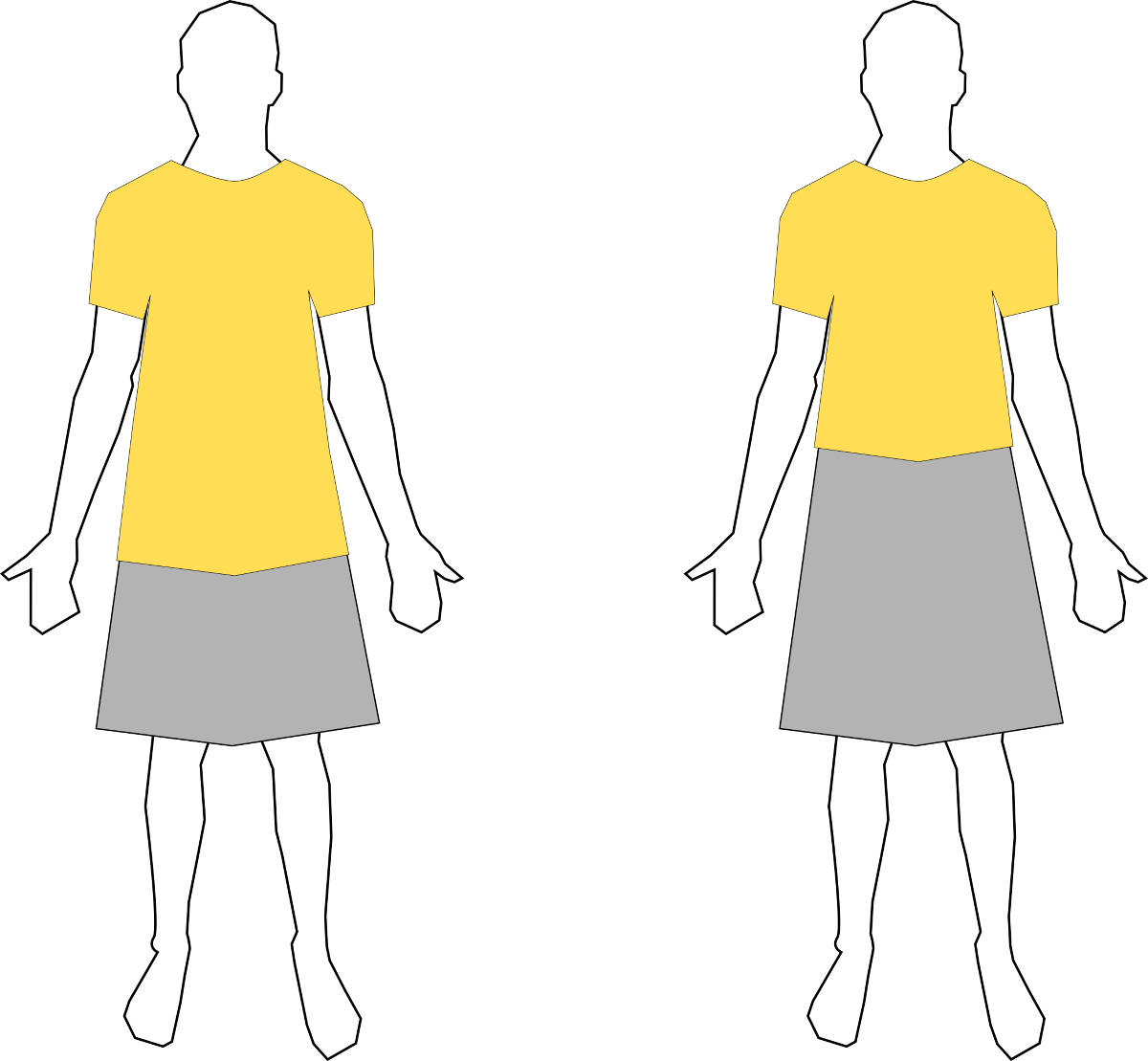
However, it should be noted that this is a proportional thing. The same normal-length t-shirt, when worn with an ankle- or floor-length skirt, looks visually balanced to me because it creates a subdivision into two equal sections.

These factors probably relate to us being used to, and probably to some extent 'genetically-trained' to expect to see the torso and legs in a given proportional relationship, and upsetting that balance can look odd. All of this means that the length of a skirt relative to the body is quite important, with some lengths looking much more natural than others.
It is easy to determine what works for an individual by wrapping a rectangle of fabric around the body. The length can be varied by folding the fabric, and multiple options can be tested to find the ones that look harmonious.
Irregular hems, V-shaped pleats, and hacking human perception
It is widely known that human perception has some oddities. For example, there are well-known optical illusions that show that:
- We perceive vertical lines as longer than horizontal ones, even if they are both the same length.
- A line will look longer when paired with a pair of short lines forming a 'V' at each end, when the V faces outwards, vs. faces inwards, even though they are actually the same length.

This can be a helpful feature in skirt design: adding triangular shapes that are wide at the bottom and narrow at the top can make the wearer appear taller. Such features can include a V-shaped box pleat that creates a shadowed section, slits that create triangles in negative space, and asymmetrical hemlines. Those features can also be combined.

Styling advice for men often recommends accentuating the broader shoulders and de-emphasising the hips, exaggerating the visual mass of the upper body. I don't know to what extent that is a culturally trained thing vs. innate to human perception, but it is somewhat at odds with skirts in general.
Wearing a skirt inevitably adds a large visual mass to the lower body and tends to draw attention downwards. This could be part of why men have come to be associated with trousers, given that less fabric around the legs de-emphasises the lower body.
Using these kinds of optical illusions in men's skirts can reduce the attention the skirt draws, helping it blend in and create a more balanced appearance overall.
Closing notes
There are numerous design choices embedded in garments sold as 'menswear' that enable them to be visually coherent with other 'menswear' garments. If one sticks to only wearing garments from within the system, these factors are invisible, and it just 'works'. However, if you break out of the system by incorporating uncommon clothes like skirts, those rules are not maintained.
Creating harmonious outfits then depends on the individual knowing what looks proportionate and coherent for themselves. Most men are not currently taught how to do this, and so it is not surprising that the resulting outfits typically look weird.
By understanding how clothing relates to the body, we can learn to incorporate skirts into male fashion harmoniously, for example, by avoiding garments that create a shape not in harmony with the body. Of course, there are many different body types, which is why these ideas will need to be adapted and may or may not work for everyone.
If you are interested in more thoughts on styling skirts, take a look at the end of my article on skirts for contra dance.